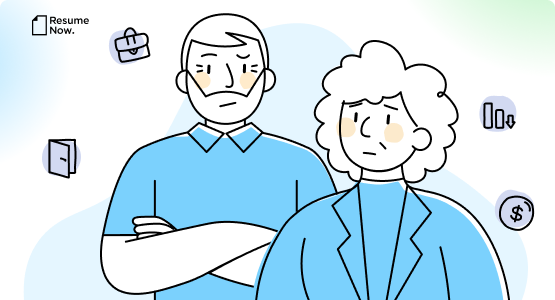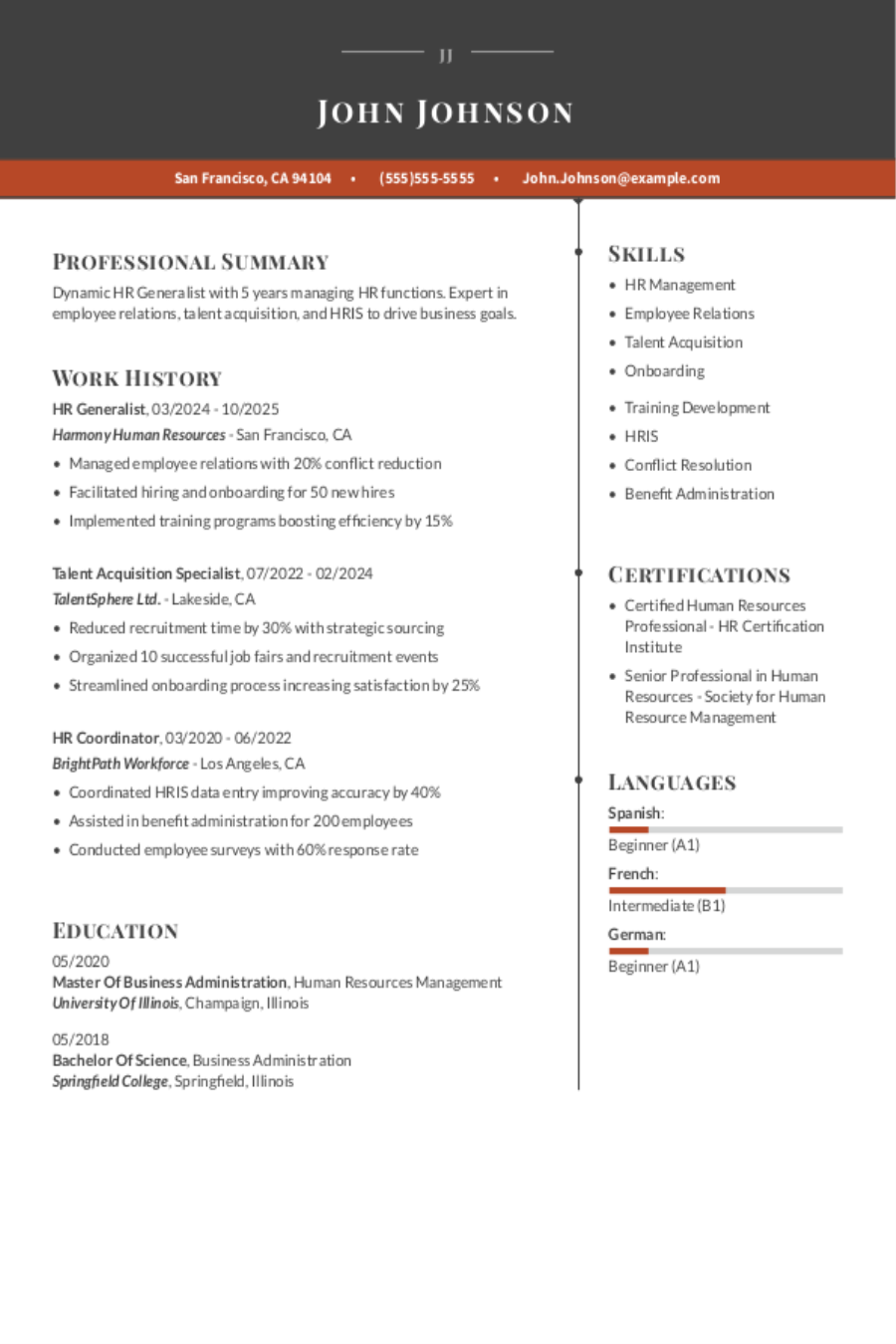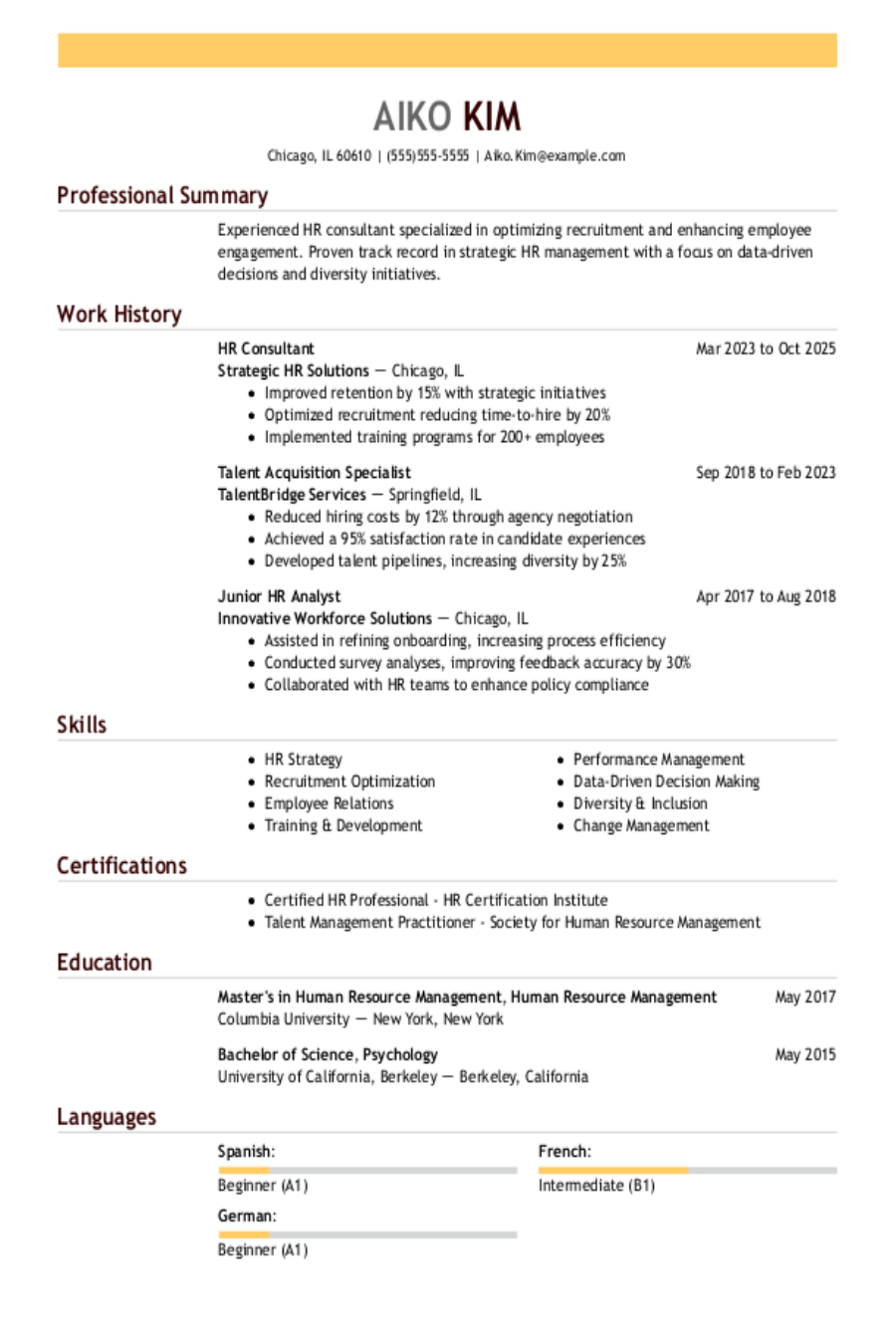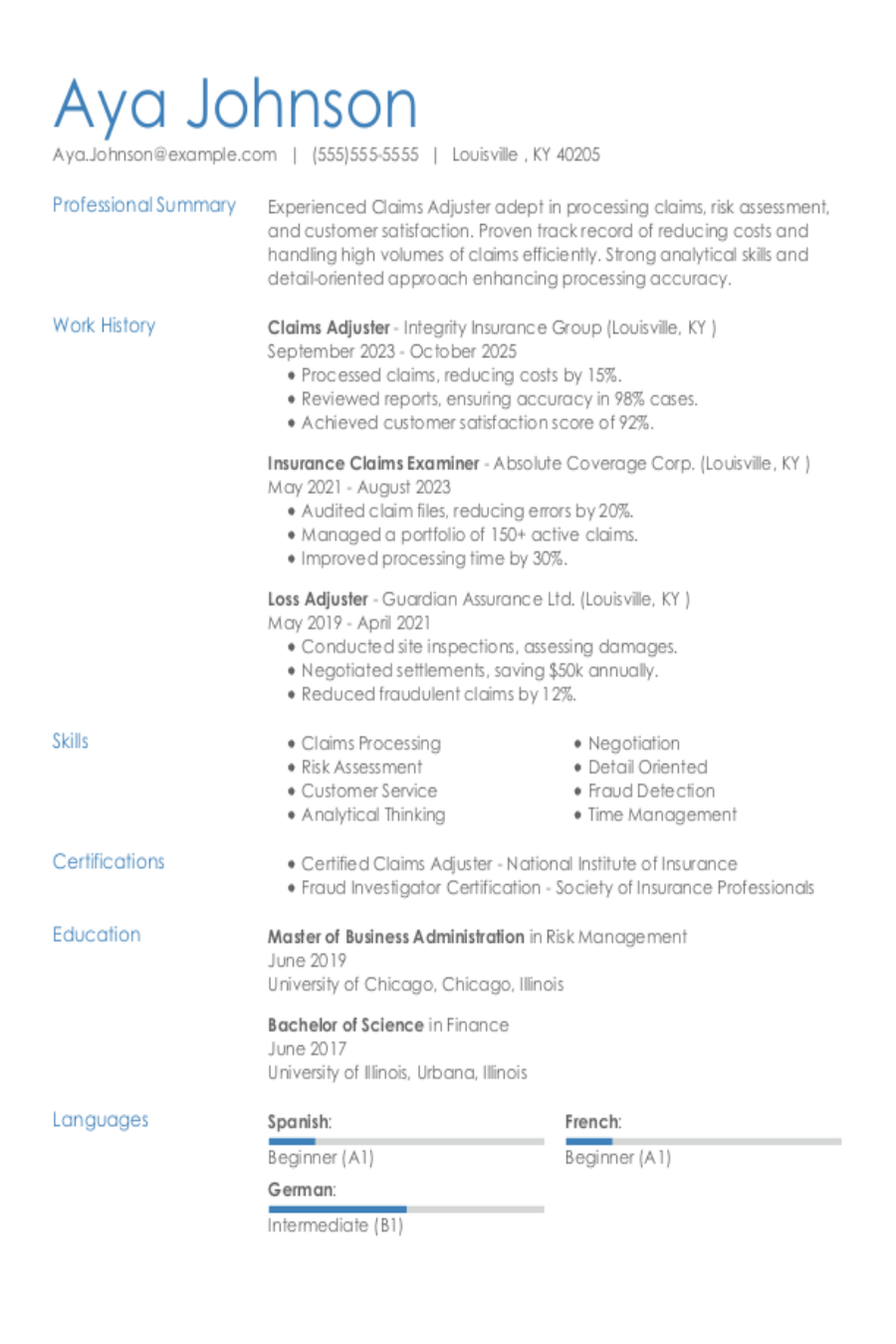Popular Web Designer Resume Examples
Entry-level web designer resume
An entry-level resume for a web designer should focus on design skills, portfolio projects, relevant coursework, and familiarity with tools like HTML, CSS, and Adobe Creative Suite to demonstrate capability.
Focuses on goals: The resume reflects a strong foundation in web design and UI/UX development, showcasing an eagerness to grow by implementing innovative solutions that boost user satisfaction and website performance.
Emphasizes soft skills: This resume highlights the applicant's strong soft skills in collaboration and problem-solving, which effectively offset limited experience.
Mid-career web designer resume
A mid-career web designer resume should emphasize a mix of design projects, technical skills, and continuous learning to effectively demonstrate creative growth and adaptability in a competitive industry.
Balances skills and experience: This job seeker's resume effectively showcases their technical expertise in responsive web design and UX optimization while highlighting a clear career trajectory from digital interface specialist to web designer, reflecting significant professional growth.
Employs active language: Powerful action verbs like "improved," "revamped," and "led" highlight a proactive approach and tangible results, showcasing the applicant's effectiveness in web design.
Experienced web designer resume
An experienced web designer resume should prioritize highlighting key projects and skills that demonstrate creativity, technical skill, and the ability to deliver engaging user experiences.
Follows traditional format: The chronological resume format effectively showcases the extensive experience of the job seeker, illustrating their career trajectory and highlighting significant achievements in web design and graphic design roles.
Highlights experience: The resume's opening summary immediately showcases the job seeker's 14 years of experience in web design, emphasizing their innovative approach to improving user experiences. This sets a professional tone that highlights their skill and commitment to delivering powerful design solutions.
No experience web designer resume
A resume for an applicant with no experience should highlight relevant skills, coursework, and any projects to showcase the job seeker's potential and enthusiasm for a web design role.
Avoids jargon: Job seekers often feel the pressure to embellish their resumes with complex terminology or convoluted explanations of straightforward tasks. However, a straightforward and clear presentation of skills and experiences is far more effective in demonstrating capability and professionalism.
Showcases extracurricular experience: Including extracurricular activities and volunteer work improves a resume by showcasing skills in web design and teamwork, which might not be evident through limited professional experience.
Web Designer Resume Template
Looking to create a standout application? Use this web designer resume template as your base—simply personalize it with your unique skills and experiences.
Alexis Cook
Seattle, WA 98104
(555)555-5555
Alexis.Cook@example.com
Professional Summary
Dynamic web designer with 6 years of experience elevating user experience and optimizing SEO. Proven success in redesigns increasing engagement by over 30% across diverse industries.
Work History
Web Designer
Pixel Perfect Designs - Seattle, WA
April 2023 - October 2025
- Increased site loading speed by 50%
- Redesigned UI for 30% more user engagement
- Implemented SEO strategies improving rank by 20%
UI/UX Designer
Creative Code Labs - Tacoma, WA
January 2020 - March 2023
- Enhanced user interface, increasing usability by 35%
- Led redesign project resulting in 40% sales boost
- Developed prototype saving $10K in testing costs
Front-End Developer
Digital Dynamics - Tacoma, WA
October 2017 - December 2019
- Coded responsive websites with 99% uptime
- Optimized scripts boosting speed by 30%
- Reduced page errors by 25% via code refactoring
Skills
- Responsive Web Design
- UI/UX Prototyping
- SEO Optimization
- HTML/CSS/JavaScript
- User-Centered Design
- Cross-Browser Compatibility
- Adobe Creative Suite
- Wireframing
Certifications
- Certified Web Design Specialist - Web Professionals Organization
- Advanced UX Design Certificate - Interaction Design Foundation
Education
Master of Fine Arts Web Design
University of Arts and Design Chicago, IL
May 2017
Bachelor of Arts Graphic Design
Creative University Los Angeles, CA
May 2015
Languages
- Spanish - Beginner (A1)
- French - Beginner (A1)
- Mandarin - Beginner (A1)
Must-Have Skills on a Web Designer Resume
A strong skills section is vital for showcasing your abilities and making your resume stand out.
Creative and design professionals transform ideas into visual experiences that engage and captivate. The skills you highlight should show how you bring originality and thoughtful insight to projects. Your resume lets you demonstrate your role in shaping meaningful, memorable work that supports broader goals.
The following data highlights essential hard and soft skills relevant to web designers based on Resume Now’s internal resume research.
When you’re ready to refine your skills section, try our AI Resume Skills Generator. It provides tailored suggestions for both technical and interpersonal skills, enabling you to create a comprehensive and effective skill set.
Writing Your Web Designer Resume
After exploring these effective resume samples, you're now ready to delve into the intricacies of how to write a resume. We'll guide you through each segment methodically, ensuring you grasp every aspect of the process.
List your most relevant skills
An effective skills section on your web designer resume should highlight both technical abilities, such as skill in HTML, CSS, and JavaScript, alongside essential soft skills like creativity and collaboration. These elements combine to demonstrate your holistic fit for the position.
Make sure to incorporate keywords from the job listing into your skills section. By doing this, you not only appeal to human recruiters seeking specific qualifications but also improve your chances of passing through applicant tracking systems. Tailoring your skills with relevant terms will show that you understand the demands of a web designer and are ready to meet them head-on.
Example of skills on a web designer resume
- Proficient in modern web design tools (Adobe XD, Figma) to create engaging user interfaces
- Skilled in HTML, CSS, and JavaScript for responsive website development
- Strong communicator with a collaborative approach to projects
- Detail-focused with an eye for aesthetics and usability
Your skills section is important for demonstrating your readiness for the web designer role. Be sure to include both technical skills mentioned in the job description and relevant soft skills. This combination shows potential employers that you are well-equipped to meet the challenges of the position while also being adaptable and collaborative.
Highlight your work history
Your work experience section should highlight the achievements that make you stand out. Think about how you've applied your design skills to improve user experiences or increase site traffic, and ensure you incorporate keywords that align with the roles you're applying for.
For each job entry, include important details like your title, the employer's name, and the dates you worked there. This information helps potential employers verify your background and timeline in the industry. Additionally, focus on specific accomplishments—such as projects completed or awards received—that demonstrate your impact at each position.
Example of a web designer work experience entry
- Web Designer
Creative Solutions Inc. - Los Angeles, CA
June 2019 - Present - Develop and implement user-friendly website designs that improve user experience, resulting in a 30% increase in site engagement
- Use HTML, CSS, and JavaScript to build responsive web pages optimized for various devices and browsers
- Collaborate with clients to understand their vision and translate it into visually appealing digital solutions while adhering to brand guidelines
- Conduct A/B testing on design elements to improve conversion rates, achieving a 15% boost in lead generation
- Mentor junior designers on best practices in design software and project management, fostering a collaborative team environment
Highlighting outcomes and achievements in your experience section is important for web designers. By showcasing specific projects that led to increased user engagement or improved website performance, you demonstrate your ability to deliver results. This not only captures the attention of potential employers but also illustrates your unique contributions and problem-solving skills, setting you apart from other job seekers.
Add portfolio work to your resume
For web designers, your resume should not only detail your skills but also draw attention to your portfolio. The challenge lies in effectively showcasing your design work while encouraging hiring managers to explore further. Highlighting specific projects can help illustrate your capabilities and creativity.
Place a prominent portfolio link at the top of your resume, ideally near your contact information. Below that, consider adding a portfolio highlights section featuring 3-4 key projects with brief descriptions. This format keeps the resume clean while directing attention to your best work.
Example of a portfolio highlights section
- E-commerce Website for Trendy Boutique – Designed a responsive site that boosted online sales by 50% in the first quarter
- Portfolio Site for Freelance Photographer – Developed a visually engaging platform that increased client inquiries by 60%
- Landing Page for Tech Startup – Created an optimized landing page resulting in a 35% increase in lead conversions
- Brand Refresh for Local Café – Revamped website aesthetics and functionality, improving customer engagement as recognized by community feedback
Include your education
The education section of your web designer resume should list your academic credentials in reverse-chronological order, starting with your most recent degree. You can exclude your high school diploma if you have a higher qualification such as an associate's or bachelor's degree.
If you are currently pursuing a degree or have incomplete education, mention your highest completed level along with an expected graduation date. Including bullet points for relevant coursework or notable projects can be helpful for those who are recent graduates or current students as it highlights practical skills acquired during their studies.
Common certifications for a web designer resume
- Adobe Certified Expert (ACE) – Adobe
- Certified Web Designer (CWD) – International Web Association (IWA)
- Google Mobile Sites Certification – Google
- Responsive Web Design Certification – FreeCodeCamp
Sum up your resume with an introduction
Your profile section is your chance to make a lasting first impression on potential employers. It serves as an introduction that summarizes your career, skills, and what you bring to the table, providing hiring managers with a clear understanding of who you are and what you can offer from the very beginning.
If you're an experienced applicant, a professional summary is the best way to showcase your accomplishments. This concise overview should highlight key achievements and relevant experiences that demonstrate your qualifications. If your experience is minimal, try making a resume objective that focuses on your career development goals.
Professional summary example
Creative web designer with over 5 years of experience in crafting visually stunning and user-friendly websites. Demonstrated ability to improve brand identity through innovative design solutions, improving user engagement and conversion rates. Proficient in HTML, CSS, and JavaScript, committed to delivering exceptional digital experiences that meet client objectives.
Resume objective example
Enthusiastic web designer eager to use creative skills and a keen eye for detail to improve user experience in a collaborative environment. Aiming to apply skill in HTML, CSS, and graphic design to deliver innovative web solutions that engage and satisfy clients.
As a web designer, your resume profile should be concise yet packed with essential information. Aim for three sentences that highlight the most critical details about your skills and experience. If you have more to share, save that for your cover letter where you can elaborate further.
Add unique sections to set you apart
Optional resume sections are an excellent way for you to highlight your unique qualifications as a web designer. These sections allow you to present a fuller picture of what you bring to the table beyond your work history.
By including relevant hobbies or volunteer experiences, you can showcase skills that align with your professional values. Unique sections can enrich your profile and resonate with employers looking for applicants who are passionate and proactive in their field.
Three sections perfect for a web designer resume
- Work Samples: Including a portfolio section on your resume is essential for web designers. Showcase 3-5 standout projects, detailing the design challenges faced and your innovative solutions, to highlight your skills and creativity effectively to potential employers.
- Client Testimonials: Incorporating client testimonials into your resume showcases your design skills and reliability. Use concise quotes that emphasize your creativity, attention to detail, or effective collaboration.
- Awards and Recognition: Including awards on your resume improves your professional profile. Highlight any relevant accolades, certifications, or industry honors to showcase your achievements and stand out to potential employers.
5 Resume Formatting Tips
- Choose a format that matches your career stage.
Choosing the right resume format is important for showcasing your skills. If you have extensive experience, a chronological format highlights your career progression effectively. For those just starting out, a functional format can emphasize your skills over work history. Consider a combination approach if you want to present both areas clearly.
- Pick a smart resume template.
Choose a resume template to improve readability and streamline formatting. Using a well-designed template ensures your information is presented clearly. If you prefer creating your own layout, keep it simple and pick fonts that are visually appealing and work well with applicant tracking systems.
- Select an appropriate font.
Opt for a clean and professional font to improve resume clarity. Fonts like Helvetica, Georgia, or Verdana ensure your information is easily read by both recruiters and applicant tracking systems.
- Use consistent formatting.
Align your resume to the left and maintain uniform margins. This improves readability and creates a polished, professional look that stands out to employers.
- Keep your resume to one or two pages.
When crafting your resume, remember that resumes should be one page long if possible. Focus on including only the most relevant information to ensure your content remains clear and engaging for potential employers.
Tools for Your Job Search
Are you prepared to apply for that exciting web designer position? Before you submit your application, take a moment to use our ATS Resume Checker. This essential tool provides valuable insights into how your resume performs with the automated systems many companies rely on for initial job seeker screening.
Looking to elevate your resume even further? Our AI Resume Builder offers tailored content recommendations specifically designed for your web design experience, along with professionally crafted templates that help showcase your creative skills and projects effectively.
Frequently Asked Questions
Last Updated: October 16, 2025
Yes. A cover letter is important as it enriches your resume’s details and offers a unique platform to engage with employers. It allows you to express why the web designer role excites you and demonstrate how your expertise makes you an ideal applicant. Take the initiative to write a cover letter that distinguishes your application.
For a streamlined process, use our AI Cover Letter Generator, which creates customized, compelling cover letters in just minutes. Choose from various cover letter template options that align perfectly with your resume, presenting a cohesive professional narrative.
A resume is a concise document typically limited to one or two pages, focusing on key skills and experiences relevant to a specific job. In contrast, a CV (curriculum vitae) can extend several pages and includes comprehensive details about your academic background, research contributions, publications, and extensive professional experience.
When applying for roles in academia, research, or specialized fields such as law and medicine, you’ll want to consider using a CV. If you feel that a CV is the right choice for your application, our online CV Maker can assist you in quickly creating an impressive document. To get started today, explore our selection of tailored CV templates designed for various industries and career levels!
A web designer resume should ideally be one page long, as this is usually enough to showcase your skills and projects. However, if you have extensive experience or a diverse portfolio, a two-page resume can effectively highlight your qualifications.
To craft an effective skills section as a web designer, mix your technical skills, such as skill in HTML, CSS, and design software, with vital soft skills like creativity and communication. In your experience section, illustrate how these skills led to successful projects or improved user experiences.
To ace your interview, practice answering job interview questions and answers. This preparation not only boosts your confidence but also equips you to handle any surprises that may come your way.
Was this information helpful? Let us know!
Hailey is a career advice writer dedicated to helping job seekers excel in their careers.
More resources

Ultimate Guide to Free Google Docs Cover Letter Templates
Look at these five best google docs cover letter templates whi...

The Respect Deficit: 9 in 10 Older Workers Report Facing Ageism in the Workplace
Resume Now s latest report uncovers widespread disrespect and ...
![People Skills for Your Resume [Synonyms and 20+ Examples] People Skills for Your Resume [Synonyms and 20+ Examples]](/sapp/uploads/2024/04/people-skills-for-your-resume.png)
People Skills for Your Resume [Synonyms and 20+ Examples]
Trying to think of the right word for people skills ? Loo...




